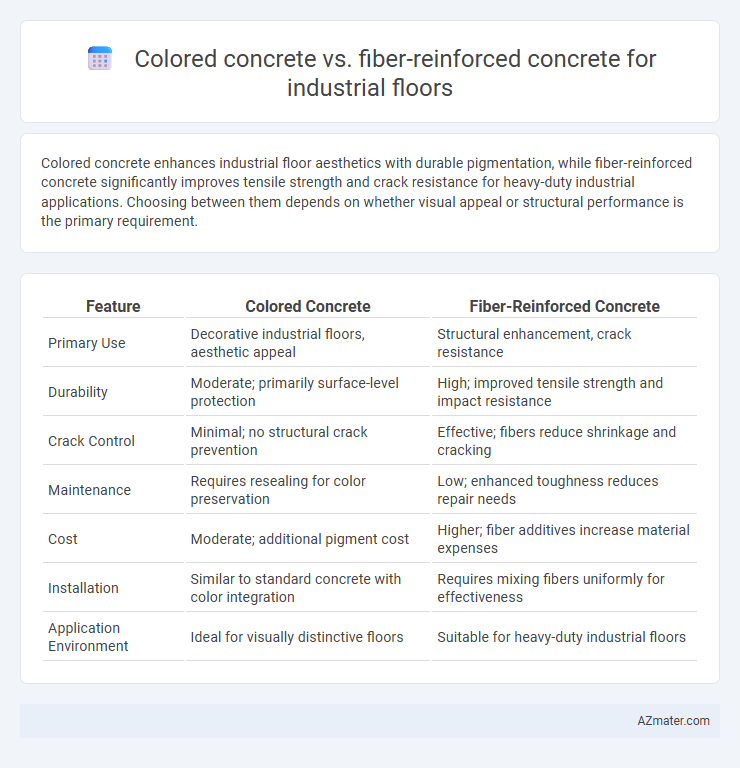Colored concrete enhances industrial floor aesthetics with durable pigmentation, while fiber-reinforced concrete significantly improves tensile strength and crack resistance for heavy-duty industrial applications. Choosing between them depends on whether visual appeal or structural performance is the primary requirement.
Table of Comparison
| Feature | Colored Concrete | Fiber-Reinforced Concrete |
|---|---|---|
| Primary Use | Decorative industrial floors, aesthetic appeal | Structural enhancement, crack resistance |
| Durability | Moderate; primarily surface-level protection | High; improved tensile strength and impact resistance |
| Crack Control | Minimal; no structural crack prevention | Effective; fibers reduce shrinkage and cracking |
| Maintenance | Requires resealing for color preservation | Low; enhanced toughness reduces repair needs |
| Cost | Moderate; additional pigment cost | Higher; fiber additives increase material expenses |
| Installation | Similar to standard concrete with color integration | Requires mixing fibers uniformly for effectiveness |
| Application Environment | Ideal for visually distinctive floors | Suitable for heavy-duty industrial floors |
Introduction to Industrial Flooring Solutions
Colored concrete offers enhanced aesthetic appeal and easy customization for industrial floors, making it ideal for environments that require both functionality and visual organization. Fiber-reinforced concrete provides superior durability, crack resistance, and impact strength, essential for heavy-duty industrial applications subjected to high loads and mechanical stress. Choosing between colored concrete and fiber-reinforced concrete depends on prioritizing either customizable design features or advanced structural performance for industrial flooring solutions.
Overview of Colored Concrete
Colored concrete offers enhanced aesthetic appeal by integrating pigments directly into the mix, creating durable and visually appealing industrial floors with a wide range of color options. It provides uniform coloration that resists fading and wear, ensuring long-lasting performance in high-traffic industrial environments. The material maintains standard concrete strength, making it suitable for industrial floors requiring both functionality and design customization.
Key Features of Fiber-Reinforced Concrete
Fiber-reinforced concrete (FRC) enhances industrial floors by significantly improving tensile strength, impact resistance, and crack control compared to colored concrete, which primarily offers aesthetic benefits. The integration of synthetic or steel fibers distributes loads more evenly, reducing maintenance and extending floor lifespan under heavy machinery and high traffic. FRC also provides superior durability and resistance to shrinkage, making it a cost-effective solution for industrial environments demanding high-performance flooring.
Aesthetic Impact: Colored Concrete Benefits
Colored concrete enhances industrial floors by providing vibrant, customizable color options that improve visual appeal and brand identity. Its ability to resist fading, staining, and wear ensures long-lasting aesthetics with minimal maintenance. Unlike fiber-reinforced concrete, colored concrete offers superior design versatility, allowing for patterns and logos that elevate the overall industrial space ambiance.
Durability and Strength Comparison
Colored concrete offers moderate durability and strength suitable for aesthetic industrial floors but may be prone to surface wear and cracking under heavy loads. Fiber-reinforced concrete significantly enhances tensile strength and impact resistance, reducing cracking and extending floor lifespan in demanding industrial environments. For high-traffic and heavy machinery areas, fiber-reinforced concrete provides superior structural integrity and long-term durability compared to colored concrete.
Maintenance Requirements
Colored concrete offers low maintenance with its durable pigment integration that resists fading and surface abrasion, minimizing the need for frequent repairs or resealing in industrial floors. Fiber-reinforced concrete enhances crack resistance and structural integrity, reducing maintenance frequency related to cracking or structural failures under heavy industrial loads. Both materials improve durability, but fiber-reinforced concrete typically demands less ongoing maintenance in environments with high mechanical stress.
Cost Analysis: Colored vs Fiber-Reinforced Concrete
Colored concrete for industrial floors typically incurs higher initial costs due to pigments and additives, while fiber-reinforced concrete may offer cost savings by reducing the need for steel reinforcement and maintenance. Fiber-reinforced concrete improves tensile strength and crack resistance, potentially lowering long-term repair expenses compared to colored concrete. Evaluating lifecycle costs reveals fiber-reinforced concrete often provides better economic value despite a similar upfront investment.
Suitability for Heavy Industrial Applications
Fiber-reinforced concrete offers superior durability and resistance to cracking, making it highly suitable for heavy industrial floors subjected to intense mechanical stress and heavy load-bearing. Colored concrete provides aesthetic appeal but lacks the enhanced structural integrity required for demanding industrial environments. For heavy industrial applications, fiber-reinforced concrete ensures long-lasting performance and reduced maintenance costs due to its improved toughness and impact resistance.
Environmental Impact and Sustainability
Colored concrete for industrial floors often involves pigment additives that may contain heavy metals or synthetic chemicals, potentially raising environmental concerns during production and disposal. Fiber-reinforced concrete enhances durability and reduces cracking, decreasing maintenance frequency and extending the floor's lifespan, which contributes to sustainability by minimizing resource consumption and waste generation. Choosing fiber-reinforced concrete typically aligns better with green building practices due to its improved structural performance and reduced environmental footprint over the lifecycle of industrial flooring.
Choosing the Right Concrete for Your Industrial Floor
Colored concrete offers aesthetic versatility and easier floor demarcation in industrial settings, enhancing visual management and branding. Fiber-reinforced concrete improves structural integrity, crack resistance, and durability under heavy loads, making it ideal for high-traffic industrial floors subjected to mechanical stress. Selecting the right concrete depends on balancing the need for visual appeal and robust performance to optimize floor longevity and operational efficiency.

Infographic: Colored concrete vs Fiber-reinforced concrete for Industrial floor
 azmater.com
azmater.com